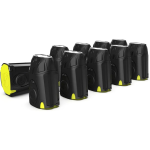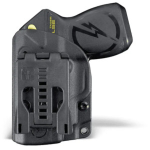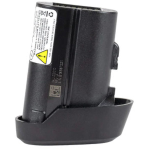Benefits of TASER Devices
Find TASER devices for sale at TBOTECH, designed for personal safety with civilian-legal features. These devices deliver an electric shock from a distance, with ranges up to 15 feet (or 12 feet for some models), offering a practical option for various situations.
Whether you’re out at night, traveling, or staying home, our TASER devices provide portability and ease of use. We include fast shipping, a 90-day money-back guarantee, and reliable quality.
Why Choose a TASER Device?
TASER devices offer a non-lethal way to stop threats from a distance, making them a useful tool for personal security in different settings.
Key Features
- Distance: Reaches up to 15 feet (or 12 feet for some models) to keep you safe.
- Power: Delivers a strong shock to temporarily disable an attacker.
- Portability: Compact designs fit easily into a purse or holster.
- Safety: Includes laser targeting and safety switches for controlled use.
- Legality: Built for civilian use—check local laws before purchasing.
Stay Secure
Protect yourself with a TASER device suited to your needs.
Featured TASER Devices
- TASER Pulse 2: A compact device with a 15-foot range, laser targeting, and a built-in flashlight. Shop Now
- TASER Bolt 2: A device with a 15-foot range, laser targeting, and a safety switch for distance use. Shop Now
- TASER Strikelight 2: Combines a 700-lumen flashlight with stun capability in a portable design. Shop Now
- TASER 7CQ: A 12-foot range device with dual-shot cartridges and laser targeting for home defense. Shop Now
- TASER X1 Professional Series: A 15-foot range device with laser targeting, suited for home or duty use. Shop Now
Buying Guide: Choosing the Right TASER Device
Pick a TASER device based on your lifestyle and safety needs:
- Range: Select 15-foot or 12-foot range depending on your environment.
- Features: Look for laser sights, flashlights, or ergonomic handles for added utility.
- Size: Choose a compact model (5-8 inches) for easy carrying.
- Accessories: Pair with holsters, cartridges, or batteries for full readiness.
- Usage: Ensure it fits your daily routine, whether for home or travel.
Frequently Asked Questions
- What is a TASER device? A self-defense tool that shoots probes to deliver a shock and stop an attacker from up to 15 feet away.
- How does it work? It uses two probes and wires to send a 50,000-volt shock, temporarily disabling the target.
- What are TASER cartridges? Cartridges hold the probes and wires for each use—find replacements in our Cartridges section.
- Is it legal? Yes, for civilian use, but confirm with local regulations.
Explore Related TASER Accessories
- TASER Cartridges – Replacement probes.
- TASER Holsters – Carrying options.
- TASER Batteries – Power supplies.
- All Self-Defense Tools – Additional safety gear.
Order Now: Get free shipping on orders over $50!



